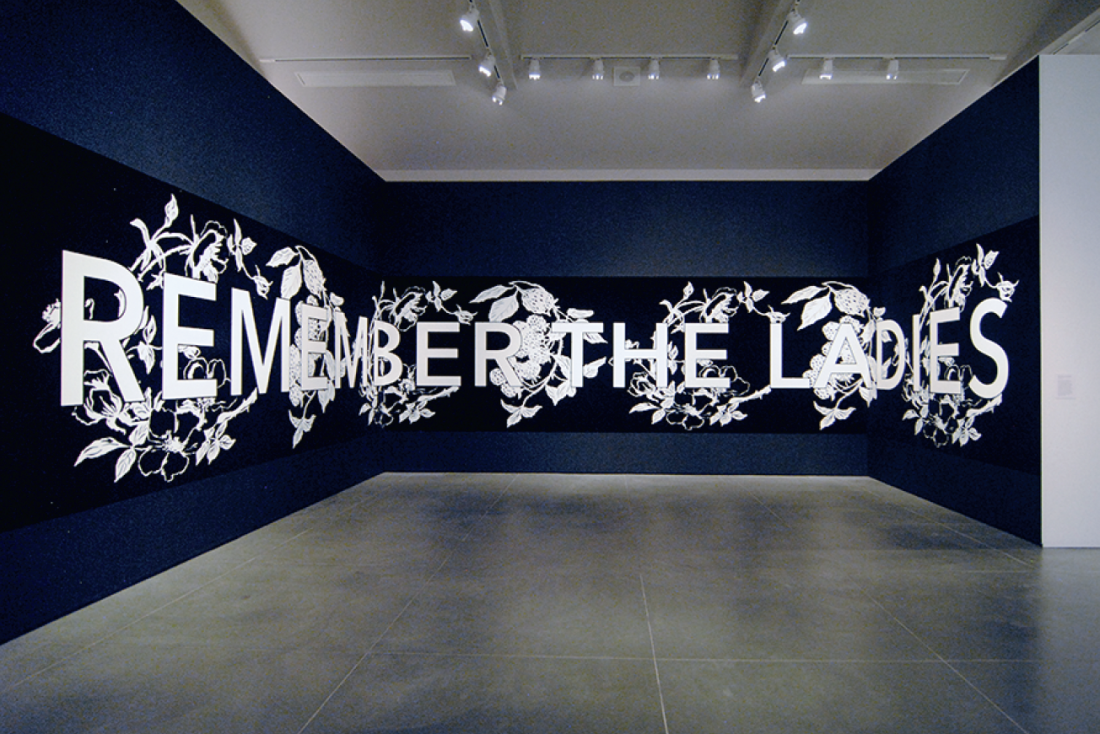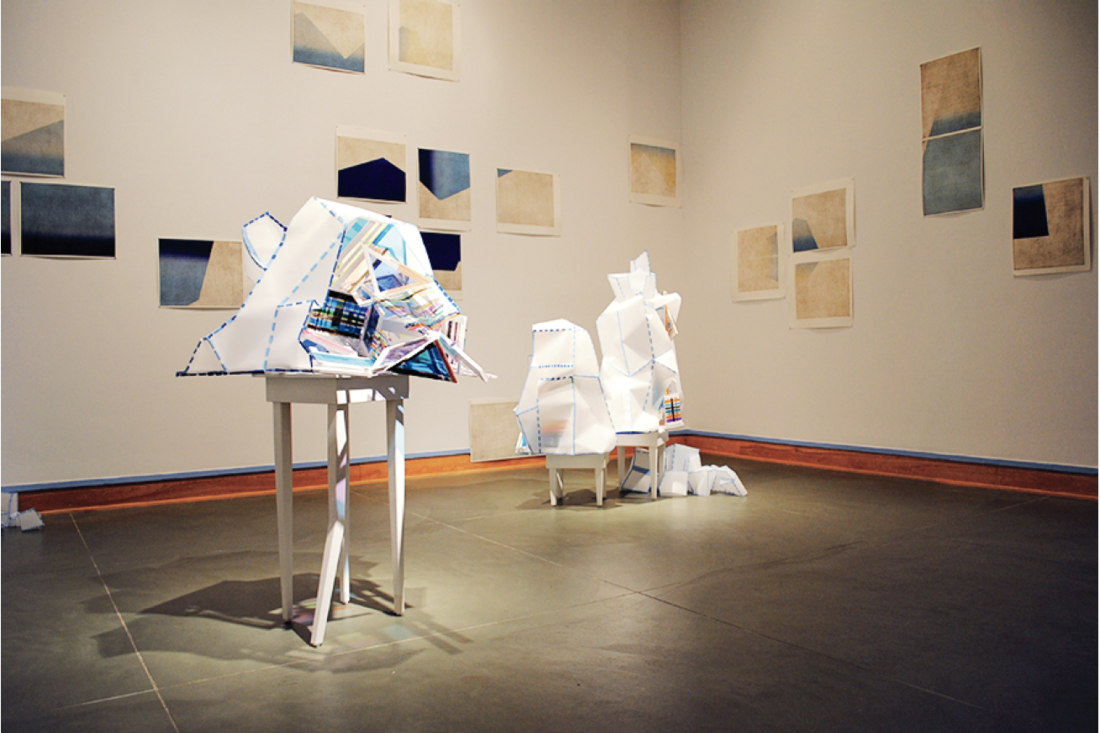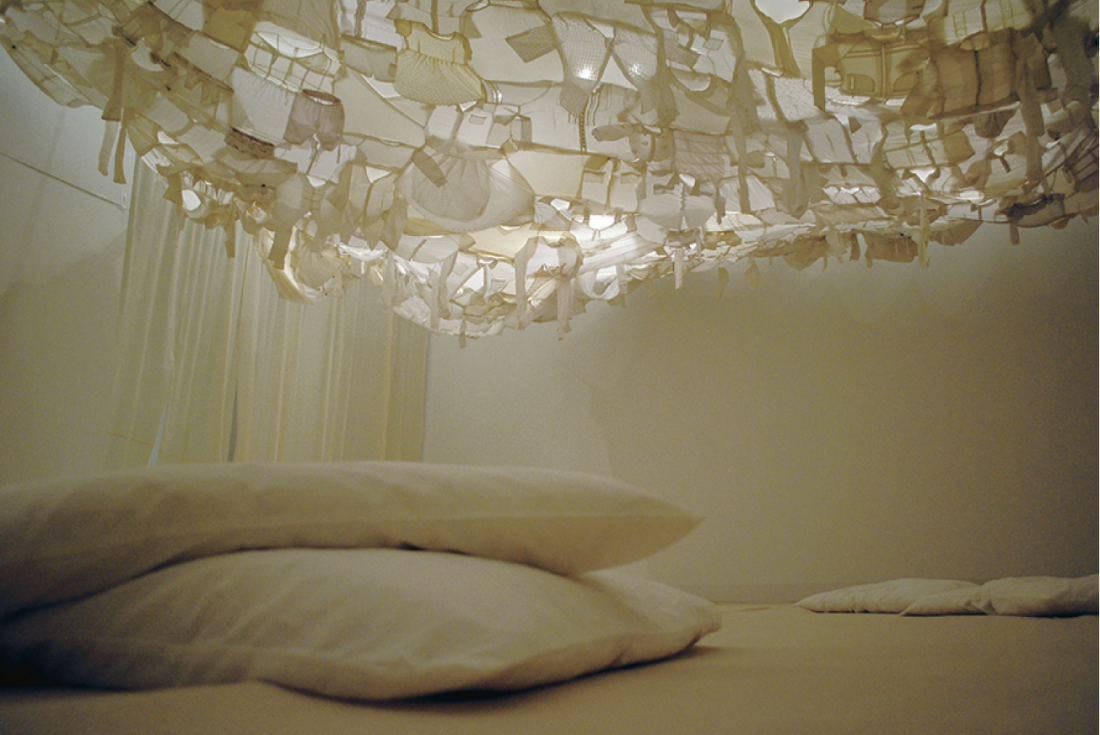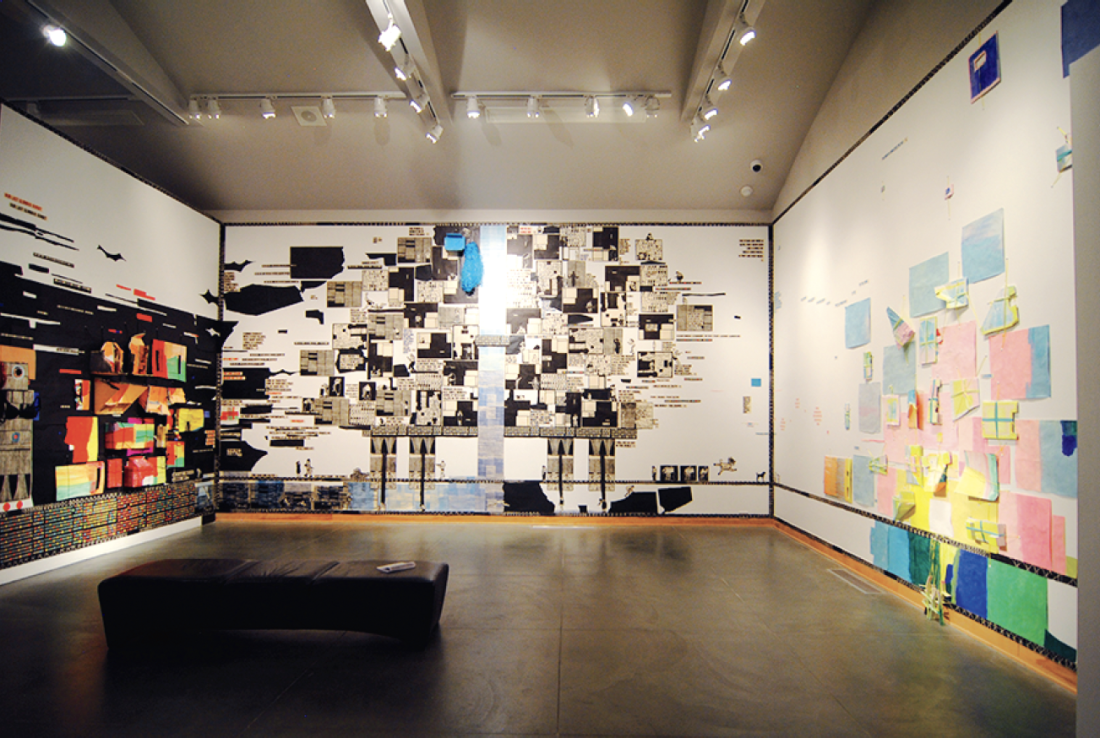“Fabrications”
Installation art is, relatively speaking, a new genre whose origins, like many iterations and idioms in “the expanded field,” are in sculpture. Typically, the objects or other components that comprise the installation artwork establish a dialogical relationship with the location in which they are situated, a relationship often referred to as site-specific or site-sensitive. This also includes the audience or spectator, as they would, in varying degrees, be actively engaged in the conceptual and spatial logic of the installation. In this sense the basic “framework” of what constitutes installation art may be understood as being either very permeable or fluid, or as impermeable and firm. The approach to and articulation of this framework, as it underlies installation art’s component elements and points of interaction, are often a key factor in determining the artworks’ meaning and success.

Gisele Amantea, Remember the Ladies (Version 2), 2017, site work, Kelowna Art Gallery, flock and paint on gallery wall, 2.7 x 19.7 metres. All images courtesy of Kelowna Art Gallery, Kelowna, BC.
A recent exhibition at the Kelowna Art Gallery (KAG) titled “Fabrications” presented a great opportunity to activate this basic thesis. Curated by Liz Wylie, the exhibition featured installations by four artists: Gisele Amantea, Yael Brotman, Libby Hague and Laura Vickerson. While each of these artists has a distinctly different material and stylistic aesthetic and way of working, they did share commonality in the labour-intensive process of their productions. The KAG’s Treadgold/Bullock Gallery, a large, undifferentiated, open room, was transformed into four quadrants to accommodate each installation. Laura Vickerson’s demarcation of the quadrant for her installation Air, 2017, featured the most self-contained enclosure in “Fabrications.” In an effort to minimize outside distractions and activate and enhance multi-sensory experience, Vickerson constructed an immersive staged “relaxation therapy” environment. At the entrance to Air, which was an unashamedly participatory piece, audience members were greeted by a ‘remove your shoes’ sign and a large circular fan blowing wind onto curtain-like banners identifying the threshold to the enchantments lying beyond. The removal of shoes served as both a sanitary procedure and a symbolic sign, for, once shorn of footwear at the approach to Air, you yielded to the authority of the space and (anticipated) experience to be had therein.

Yael Brotman, Mountains dance like rams, 2017, foam core, Mylar, paper, ink, theatre gels.
Inside, the opening theme was reinforced by an audio broadcast of wind in different stages of velocity, but now paired with a physical and visual field of white gallery walls, and off-white and white fabrics covering floor and ceiling. The sound of a soft breeze fit nicely with the comfort of sitting or walking on the canvas and carpet underlay floor covering. Foam-filled white pillows were strewn about the floor, and overhead were white garments and undergarments sewn together to form an ambiguous, yet emotionally charged, floating fabric canopy. The artist’s success in orchestrating the sensory modalities of Air contributed to its overall theatricality and artifice; and yet, in an effort to control the framework of sitespecificity and, more specifically, the installation space as a distinct simulacrum micro-environment, that success was undermined by one compromising element. At the base of the walls in the KAG there is a six-inch gap from the bottom of the wall to the floor plane, which houses wraparound wood panelling and electrical plug-in strips. In an attempt to conceal this architectural feature, the artist rather hastily placed strips of cut white card paper around the perimeter boundaries of the space. It looked improvised and it clearly was. At a glance this manoeuvre supported the “whiteness” of the space, but its failure resided in its reluctance to directly acknowledge and articulate the location in which the installation was sited, and in the conceptual misjudgment of the audience’s ability to engage with a sensory and theatrical experience in other than a seamlessly constructed environment.

Laura Vickerson, Air, 2017, white clothing, rope, carpet underlay, canvas, muslin, pillows and sound.
Yael Brotman’s piece, titled Mountains dance like rams, 2017, was the most sculptural/objectbased installation in the exhibition. Exclusively utilizing paper and paper-related materials such as Mylar, foam core, theatre gels and tape, Brotman’s architectonic sculptural fabrications maximized interior-exterior form relationships. This inside-outside constructivist “anatomy” evoked not only built environments, but biological forms such as human subjects and, more provocatively, the internal and external composition of the geological world, perhaps nature at large, suggesting there’s something internal to everything. That’s a big achievement for works that were modest in scale. The main body of each of these eccentric, nearabstract constructions was placed on foam core furniture stands, lending them the appearance of models rather than stand-alone sculptures. In some the outer paper shells were folded back to expose an interior panoply of planar elements bursting with patterns and colour, spilling onto and often over the table support’s edge. These were very active sculptures, which worked well in the round and engaged the architecture of the space in an intelligent, sculpturally minded way. The only drawback to her installation were the unframed paper works on the wall. While interesting in their own right, they and the sculptural elements failed to reconcile their different identities to combine in forming an artistic and conceptual mediation of their outward incompatibilities.

Libby Hague, Habitat, 2017, woodcut prints, painted paper, papier mâché sculpture, wigs, belts, hardware. 57580txt_
Presentation design is part of installation art’s lexicon and field. In large part pioneered by Barbara Kruger, this artistic paradigm is open to many permutations—some might argue too many. That said, when it’s done effectively by artists such as Kruger, Thomas Hirschhorn or Canadian artist Libby Hague, you can be assured the term “installation art” means much more than a linguistic enhancement of a display of art objects. Hague’s installation, titled Habitat, 2017, was the amazing mix of a multi-linguistic, text-image- material, polyvocal, microscopic diorama of life on earth; known, unknown, to be discovered, imagined and invented. On a purely visual level, it’s a joy to behold. Mind you, it wasn’t easy to take in, so you had to exercise patience, not quick judgment, to fully experience the rewards of stimulating the retina and the objective mind and imagination. Covering three intersecting walls from floor to ceiling, and composed of a mixed-material palette of woodcut prints, painted paper, wigs, belts, papier mâché relief sculptures and hardware, the piece was dense, and that is not to discount the other “voices” that comprised this micro-fragment of “all that there is.” In this type of installation, the quality of the design is often the tipping point in the work’s success. Libby Hague hit all the right buttons. The placement of diverse elements, graphics and text lines and the design layout overall were comparable to free jazz improvisation, with rhythmic bass-line threads holding the map together through flights of abstraction, melodic structures and bursts of syncopation.
Gisele Amantea’s piece was actually the first installation that the “Fabrications” audience encountered upon entering the gallery, and what an entrance it was. Remember the Ladies (Version 2), 2017, while not specifically created for this show (it was version 2), did set in motion a gender-cognizant reading of the exhibition. The piece was a neo-Arts and Crafts wall mural that John Ruskin and William Morris would have loved. Like Libby Hague, Amantea sited her image-text flocked and painted surface installation on a three-wall diorama. It consisted of a striking combination of white graphics on a black ground; it was so bold in its appearance as to make it marginally intimidating. You experienced a sense of excitement entering this oversized alcove, brought about by the sheer spectacle of the articulated space, and by the abstraction embedded in the phrase “Remember the Ladies.” In the end, Amantea and the other artists (ladies) in the exhibition—and that would include curator Liz Wylie and contributing writer Diana Sherlock, who wrote a fascinating catalogue essay—collectively have, in “Fabrications,” mounted an exhibition that made installation art a vital and interesting subject of conversation and critique again. ❚
“Fabrications” was exhibited at the Kelowna Art Gallery, Kelowna, from February 4 to April 16, 2017.
Gary Pearson is an artist and associate professor in the Department of Creative Studies at UBC Okanagan.

